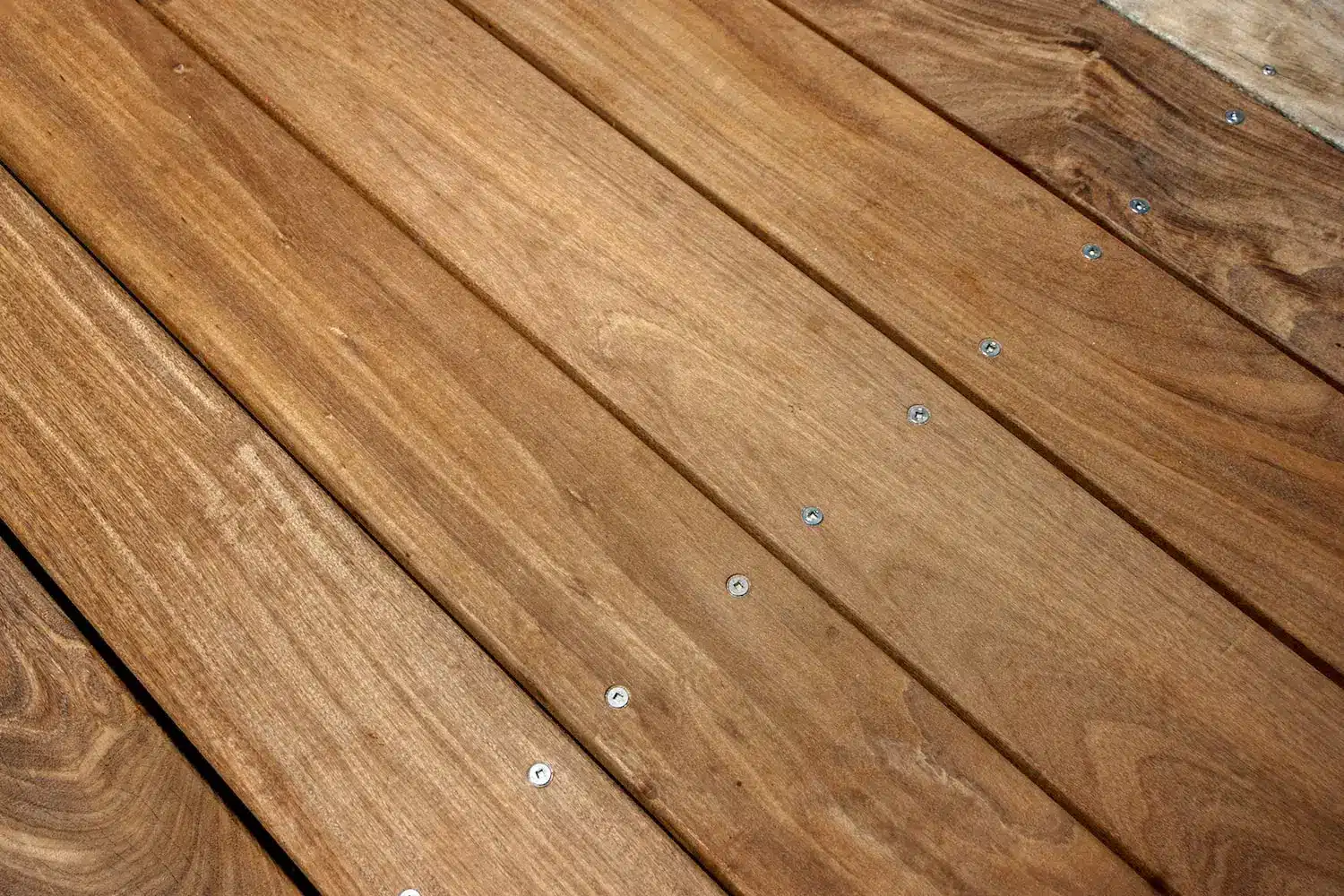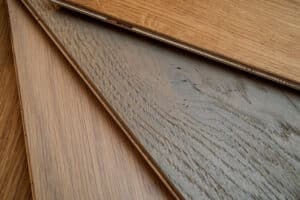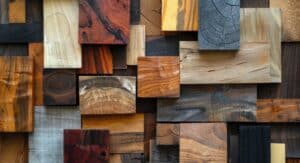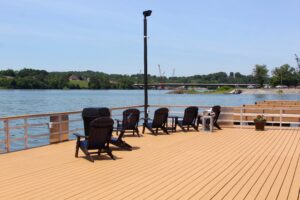Hardwood decks are famous for their deep, rich colors and longevity. There are tons of hardwood varieties out there, all ranging in price, color, and durability. If you’re considering hardwood for your next project, you may be wondering how to decide which kind is right for the job.
In this guide, we explore the differences between hardwood and other decking options, some popular exotic hardwood types, and maintenance tips for extending the length of a natural timber deck.
Hardwood vs. Softwood & Composite
Decking may either be natural timber or artificial composite material. Each type varies in cost and lifespan, so choosing the right decking option will determine what kind of upkeep and repairs a deck will require in the future.
Let’s see how hardwood stacks up against softwood and composite options.
Softwood Decking
Softwoods often come from conifer trees—mostly commonly pines, firs, and spruces. Softwood is cheap and easy to work with, which is why many commercially made furniture pieces are made with pine. Treated softwood timber (such as Southern Yellow Pine) is often used for decks, docks, and piers. However, this timber tends to be less water-resistant, more prone to rot and weather damage, and shorter lived than hardwood.
Hardwood Decking
Hardwoods are usually from trees that grow in tropical climates. Unlike softwoods, hardwoods contain pores that efficiently move water throughout the wood, rather than keeping water absorbed. These woods are naturally resistant to moisture, as well as rot, mold, algae growth, and marine boring pests. While hardwood structures are more expensive to install, they can last much longer than softwood structures and require less maintenance in the long-run.
It’s important to note that hardwoods are usually physically harder and denser than softwoods. So hard, in fact, that most hardwoods require specialized tools, drill bits, and saw blades to work with. This means hardwoods aren’t suited for most home DIYers and need pros for installation.
Composite Decking
Finally, composite decking is typically made of a natural wood core surrounded by a protective shell composed of artificial or recycled materials. Composite’s biggest selling point is its lack of required maintenance—it never needs to be re-stained or re-sealed. However, composites don’t provide the “natural flair” of real wood and may look artificial in certain colors. Depending on the brand, composite may also be more expensive and difficult to work with than natural timber.
Types of Hardwoods for Decks
There are hundreds of species of hardwood used for outdoor purposes. In addition to domestic hardwood classics like maple and redwood oak, exotic hardwoods are growing in popularity for their luxurious colors and unmatched longevity. Exotic hardwoods refer to those grown in tropical regions in the southern hemisphere, such as Brazil.
Some of the most common kinds of exotic hardwoods include:
- Ipe. Native to Central and South America, ipe hardwood is a beautiful, long-lasting choice for luxury decks. With its natural rot resistance, ipe is a relatively easy hardwood to maintain, but does involve more upfront costs than other options. Ipe colors range from medium to dark reddish browns.
- Garapa (Brazilian ash). Also from South America, garapa is a more affordable alternative to other hardwoods, though it’s not as durable as higher-quality ipe or cumaru. Garapa is naturally a light-to-medium golden brown color.
- Cumaru. Cumaru may be considered a middle ground between ipe and garapa in terms of price and durability. Cumaru has a shorter lifespan than ipe, but is significantly less expensive. Its color range is versatile and includes hues that span from mid-tone honeys to darker red-tinted browns.
- Tigerwood. Famous for its unique natural stripes, tigerwood looks as fierce as it is to handle. Because of its hardness, tigerwood requires experience and specialized tools to pre-cut and install each board. It’s expensive because of both material and labor costs, though tigerwood is one of the highest quality timbers for outdoor uses.
- Balau. Indonesian balau is excellent for tropical climates thanks to its strong natural water resistance. Red balau is a similar rich red-brown color as ipe, while yellow balau has a lighter honey tone like cumaru. Balau is often a cost-effective option for decks, but may be more difficult to source because of its rarity.
How to Maintain & Clean Hardwood Decking
Hardwood decking requires yearly (or sometimes twice yearly) maintenance to maximize its lifespan. In areas where it regularly storms or snows, decks may need more attention throughout the year to make sure dirt and mineral deposits don’t pile up.
To clean and maintain hardwood:
- Sweep to clear off any debris. Wash the boards with a deck brush and either an oxygenated hardwood cleaner or a bucket of warm, soapy water. (If necessary, a pressure washer can be used to clean off any stubborn dirt, but start with the lowest PSI setting possible to avoid damage to the wood grain.) Wait until the timber is completely dry before going onto the next step.
- Use a random orbital sander to gently sand the surface of the deck. Go with the grain and smooth down any rough edges you may notice. If the deck has started to fade due to sun exposure, sanding may also restore some of the original wood color.
- Apply an oil-based UV protective sealant. Test the sealant in a small, discreet area to check the look of the sealed wood. Use a deck brush (not a sprayer or stain pad, as these can leave streaks) to apply sealant.
- Wait until the deck is fully dry before putting any furniture back.
How long does hardwood decking last?
The average life expectancy of hardwood depends on the species of wood used, how often it’s maintained, and the harshness of the environment it’s in.
If taken care of properly, many hardwood decks can last a generation or longer even if they’re exposed to a lot of foot traffic or harsh seawater environments. Expect most decks to last between 10 and 25 years—although ipe has been known to last up to 75 years outdoors.
Thinking hardwood for your next project?
Hardwood is perfect for luxury decks—and easy to transport to the job site when working with Harbor Exports. We work with the nation’s best suppliers of high-quality exotic hardwoods to give your next project a stunning finish.
To learn how Harbor can help you import lumber to your job site, call us at +1 (954) 834-6200 or click here to contact us.
- About the Author
- Recent Posts
Brad Enfinger has been in construction for over 20 years and has been involved with every material from concrete slab to laying the roof on houses. Brad’s diverse experience has given him the knowledge needed to assist those with shipping building materials, whether it be a house, pole barn, deck, or a dock. Brad at Harbor Exports has anything for your building material needs and can export material all over the world.




